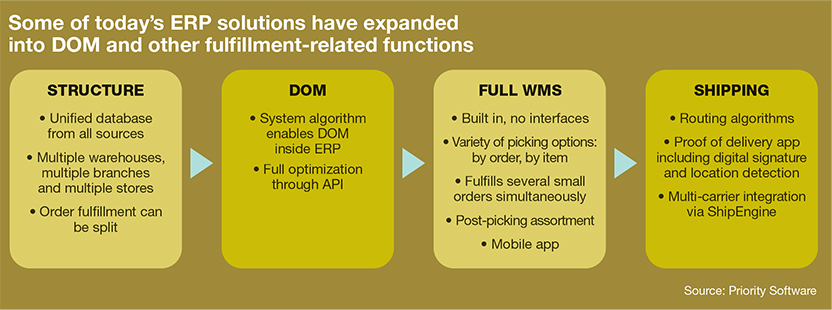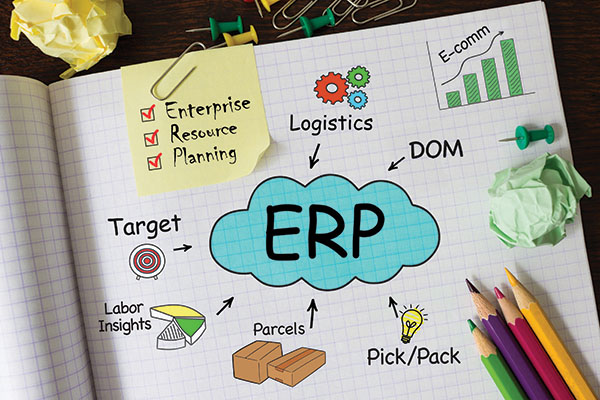ERP in the age of omni-channel
In recent years, enterprise resource planning solutions have lost some luster, even being called “back office” systems. They’re useful for financials, procurement and transactions, but can ERP drive omni-channel fulfillment? The short answer is “yes.”
Since growing out of earlier forms of enterprise systems in the early 1990s, enterprise resource planning (ERP) systems have become the backbone business management software for most enterprises. They span functions including accounting, procurement and, for some ERP vendors, they also include warehouse management system (WMS) capabilities.
This scope makes ERP software important, but in an era when companies are seeking competitive advantage with omni-channel fulfillment, is ERP still business-critical?
The answer might be “no”—at least for legacy ERP deployments used mainly for back-office processes while e-commerce fulfillment is handled by best-of-breed solutions for WMS or other functionality such as distributed order management (DOM).
On the other hand, for ERP solutions that have evolved to include functionality in areas like WMS, or ERP providers that have aimed from the get-go at targeting omni-channel environments, ERP remains vital. When a vendor can blend ERP with e-commerce platforms and WMS, it can be an appealing combination, says Ray Rebello, director of product marketing for Acumatica, a Cloud-based ERP vendor.
“You can build an amazing system for taking e-commerce orders, but the fulfillment end can fail completely if you’re using older, disconnected systems that weren’t equipped to handle the fulfillment of online orders in volume,” says Rebello. “What is needed is a central system that functions as a single source of the truth.”
ERP can be that central platform if the vendor has tested integration to e-commerce platforms, WMS or store-level systems on the execution side, explains Rebello. “Enterprises with omni-channel requirements need to know the details around product availability across locations, arrival dates and times for replenishment, product information and pricing data,” he says. “Making all of that accessible can require duplicate data entry or custom integration unless you have a single source of the truth. That’s the beauty of a modern ERP system—everyone involved has consistent, accurate information.”
ERP evolves
ERP first gained prominence by combining enterprise functions such as financials, manufacturing planning, procurement and order entry into one integrated suite. Fueled by the rise of relational databases and client/server architecture, ERP boomed in the 1990s.
Of course, ERP has continued to evolve, with many of the larger vendors like SAP and Oracle either building or buying extended functionality in areas like supply chain management software, including WMS. Numerous other ERP vendors also offer WMS as an integrated module.
ERP vendors have also evolved by offering richer analytics and business intelligence (BI) features and updating their architectures for Cloud computing. The result: many ERP deployments today are far from being outdated legacy systems.
Acumatica’s solution set, for example, offers both WMS and retail point of sale (POS) applications depending on the industry needs of the user company, says Rebello. Through integrated systems for warehouses and stores, a retailer trying to support omni-channel gets an integrated view of order data, inventory data and fulfillment processes. “For omni-channel, you want details like product descriptions, shipments and inventory availability to be available in one place so everyone is working with the same information,” Rebello says.

Like numerous other ERP suppliers, Acumatica integrates with third-party e-commerce platforms from vendors such as Magento and Shopify. Many companies use these e-commerce front ends, says Rebello, so Acumatica uses application programming interfaces (API) to integrate to these platforms.
DOM capabilities shine as e-commerce grows
One of the main functions of an enterprise resource planning (ERP) system is order management, although with multi-channel selling, it may not be an ERP system that carries out the order orchestration. That’s because more companies are using distributed order management (DOM) software, a type of order management system adept at “sourcing” from the best place to fill orders from, whether that be a warehouse, a retail store or other options like drop shipments or third-party warehouses.
The providers of DOM include vendors such as Manhattan Associates, Softeon and Deposco, and now Tecsys, from its November 2018 acquisition of OrderDynamics. In addition to DOM, these vendors also offer supply chain execution software including warehouse management system (WMS) solutions. While not head-on competitors to most ERP vendors, DOM vendors can help companies with omni-channel fulfillment requirements.
DOM solutions are fundamentally different from traditional order management in that they are geared toward filling small direct-to-consumer orders, explains Peter Brereton, president and CEO of Tecsys.
“We’re finding that our traditional client base now needs to directly fill orders for the consumer, either through sales from their own Websites, or they need to support their clients who rely on them to do the fulfillment,” Brereton says. “Either way, they need a distributed order management platform that can receive the consumer order, figure out where to source it from, and carry through on the fulfillment, including payment processing and all the returns management functions that might be needed.”
DOM excels at figuring out which warehouse or store location is best to fill an order from, not only in terms of inventory availability, but more nuanced factors such as labor availability at the store level to pack orders, says Brereton, or whether one location has overstock of an item. Traditional order management systems aren’t geared toward these granular sourcing decisions, Brereton explains, but such capabilities are becoming necessary “because the path to the consumer involves thousands of tiny consumer-level orders rather than hundreds of pallet-sized orders.”
In the broader retail industry, Brereton sees a “convergence” between traditional retailing and e-commerce selling as the driving force. Traditional upstream parties like suppliers, brand managers and distributors are caught up in this trend, says Brereton, and to succeed, they must be nimble when it comes to processes like e-commerce drop shipping or servicing channels in a more end-to-end manner.
Meanwhile, established software vendors need to expand into richer e-commerce fulfillment functionality to remain relevant, Brereton says. “This is going to be a convergence game for the next few years,” says Brereton. “The players who figure out this convergence trend and how to support it are going to be the winners.”
Pretested, API-based integration is a must to interoperate in real time with e-commerce platforms, says Efrat Nakibly, vice president of marketing and strategy with Priority Software, a Cloud-based ERP provider. “Ultimately, you want sales orders from all channels to go immediately into [ERP] so that the ‘big picture’ remains in one place,” says Nakibly.
Priority’s solution set includes a WMS option to support companies with distribution operations, as well as DOM functionality. The vendor also partners with ShipEngine for integrated parcel shipping functionality. However, says Nakibly, it’s the overall flexibility of an ERP system, as much as breadth of features, that makes for a good solution.
“The top concern should be how flexible is the system and how easy is it to grow the system over time,” says Nakibly. “To help achieve these goals, the system must be open, using APIs, to integrate with any third-party system or device.”
Best-of-breed WMS vendors have in some cases partnered with ERP vendors to provide a pretested integration between ERP and WMS. This relationship offers advanced WMS without the integration worries of a typical bolt-on project, says Carl Marin, global solution area leader for small to mid-sized business (SMB) with HighJump Software, a WMS provider.
HighJump’s Warehouse Edge, a Cloud-based WMS, has been pre-integrated to multiple ERP solutions, including systems from NetSuite, Microsoft and Sage. The WMS has capabilities in areas like order waving, zone picking and integration to warehouse automation. HighJump has been offering these integrated solutions for several years, adds Marin, which appeals to SMBs who see integration as a risk. “Our intention is to reduce that risk by packaging up the integration as a product,” he says.
Orchestration & analytics
Helping companies with omni-channel challenges has a front-end order aspect to it and a set of downstream fulfillment execution activities, both of which need software support, says Markus Rosemann, vice president for digital logistics and order fulfillment with ERP vendor SAP. Over the years, SAP has enhanced its WMS solution known as eWM, most recently making it an “embedded” application to the SAP flagship ERP suite, Rosemann says. Additionally, SAP has continued to enhance its order management functionality, in part using e-commerce software from its 2013 acquisition of Hybris.
For some SAP users in retail environments, Hybris is used as the front-end e-commerce platform, explains Rosemann, though when it comes to order-sourcing decisions, the Hybris platform communicates with an “Advanced Available-to-Promise (ATP)” function in SAP’s ERP system. It is this Advanced ATP engine that is the key to order sourcing decisions for SAP users, explains Rosemann, though some SAP users who use the Hybris platform will have the Hybris software involved on the front-end of the process.
In general, adds Rosemann, SAP has evolved and enhanced its order orchestration for omni-channel, as well as execution functions like WMS. “In the end, [omni-channel support] is all about the orchestration of the larger process—the distributed order management—as well as fulfillment execution elements,” says Rosemann.
Analytics is another WMS enhancement focus for SAP, adds Rosemann. The WMS has a set of key performance indicators (KPIs) called Warehouse Insights that address issues such as inventory slotting and labor resource planning. Currently, the KPIs are driven by more conventional analytics and optimization techniques, but Rosemann adds that SAP is looking for opportunities to apply machine learning within the WMS.
Rosemann believes machine learning’s ability to uncover patterns in customer order profiles, order velocity and inventory levels could potentially be harnessed to generate recommendations on replenishment levels, warehouse labor requirements or to help support wave-less picking. “Those are some of the ideas we have as next steps,” says Rosemann.
New breed ERP
The omni-channel era has also seen the rise of new types of enterprise systems focused on omni-channel selling and fulfillment. For example, Skubana CEO Chad Rubin says Skubana’s solution can be considered a “next-generation ERP system” because it focuses on issues like multi-site, multi-channel inventory visibility and a flexible order orchestration function called “Orderbots.”
Such capabilities, says Rubin, help a company sell and fulfill across multiple channels, and coordinate inventory positions and allocations across their own sites, with third-party logistics (3PL) provider warehouses or with Fulfillment by Amazon (FBA) sites and operations. “We’re the new wave,” Rubin says. “We allow you to operationally run your business any way you want to fulfill.”
Rather than focus on what Rubin calls “old school” ERP functionality like accounting, Skubana’s focus is on functions like multi-channel order orchestration. The system also uses intelligent bots to automate creation of purchase orders for approval, rather than have workers create POs from scratch. “We focus on the core components necessary to equip your business for modern-day commerce,” says Rubin.
Acumatica’s Rebello points out that ERP systems are no longer limited to business-to-business order management. The right ERP solution can process and fulfill orders from an e-commerce platform, from a marketplace, from electronic data interchange, phone orders or conventional B2B orders. “Wherever the order comes from, it shouldn’t matter to the ERP system—that is the key to omni-channel support,” says Rebello.
Companies mentioned in this article:

Article Topics
Inventory & Picking News & Resources
Siemens, Universal Robots, and Zivid partner to unveil smart robotic picking solution AI-based inventory monitoring solution provider Gather AI raises $17 million NRF 2024 retail sales forecast calls for growth Swisslog gives live demonstration of ItemPiQ latest evolution Cimcorp automates fresh food distribution with flexible storage, order picking solutions ABCO Systems acquires FastFetch The Ultimate Guide to Reducing Warehouse Travel More Inventory & PickingLatest in Materials Handling
Registration open for Pack Expo International 2024 Walmart chooses Swisslog AS/RS and software for third milk processing facility NetLogistik partners with Vuzix subsidiary Moviynt to offer mobility solutions for warehouses Materials Handling Robotics: The new world of heterogeneous robotic integration BSLBATT is looking for new distributors and resellers worldwide Lucas Watson appointed CSO for Körber’s Parcel Logistics business in North America Hyster recognizes Dealers of Distinction for 2023 More Materials HandlingAbout the Author
Subscribe to Materials Handling Magazine

Find out what the world's most innovative companies are doing to improve productivity in their plants and distribution centers.
Start your FREE subscription today.
April 2024 Modern Materials Handling

Latest Resources












